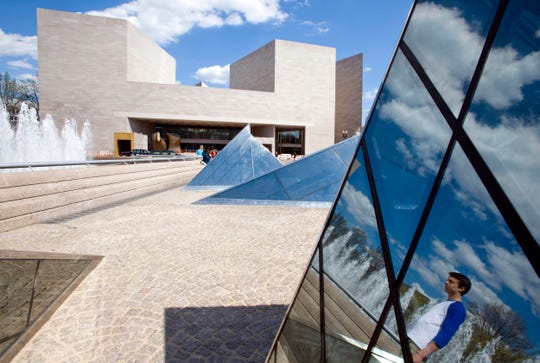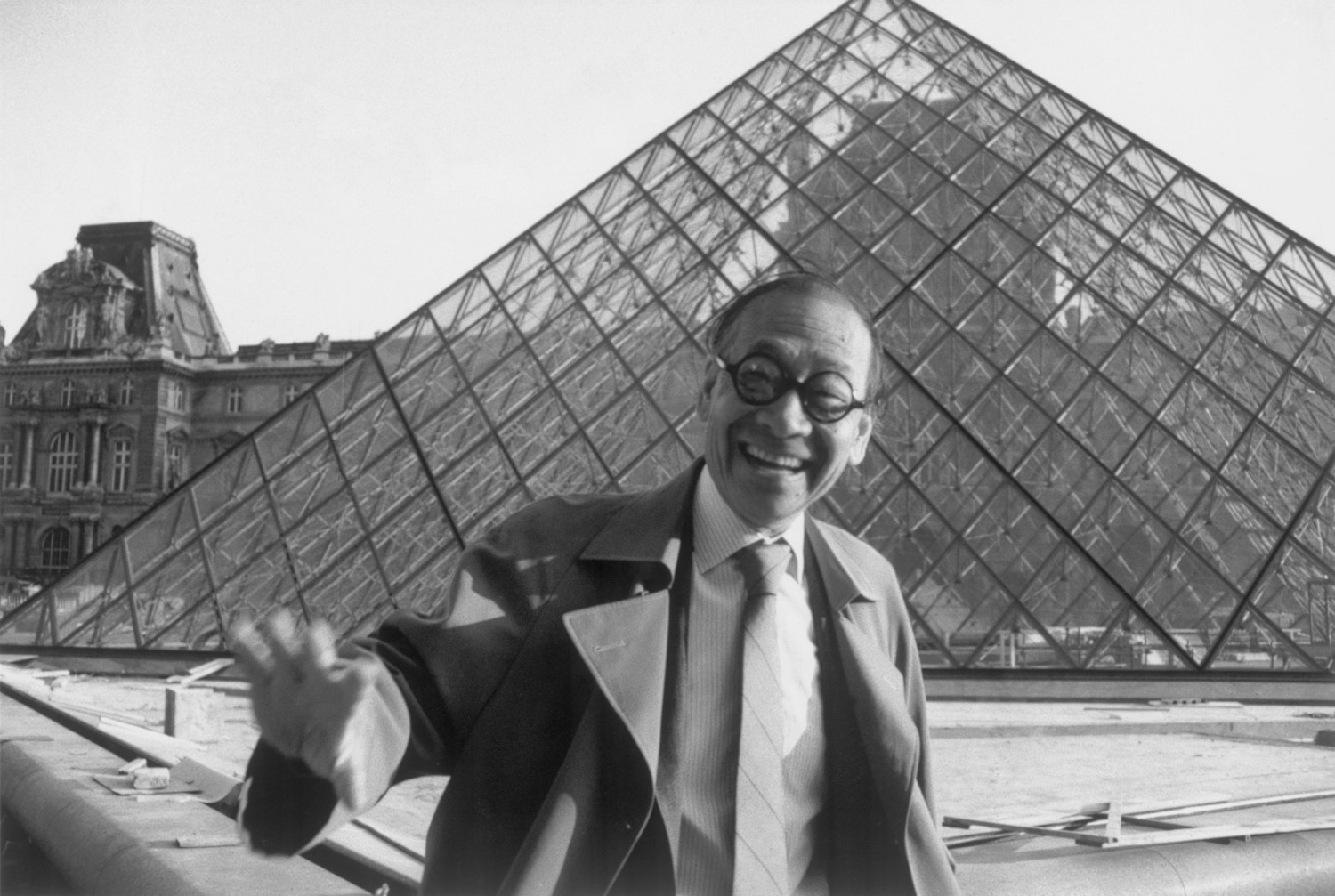This article is more than
5 year oldI.M. Pei, acclaimed architect of buildings known around the world, dies at 102

I.M. Pei, the Chinese-born, American-trained Modernist architect whose work transformed cities around the world and was widely celebrated by fellow architects, has died. He was 102.
Marc Diamond, director of communications for Pei's storied firm, Pei Cobb Freed & Partners, confirmed his death to USA TODAY on Thursday.
The New York Times architecture critic, Paul Goldberger, reported his son, Li Chung Pei, confirmed he died overnight. A cause was not disclosed.
After the news broke, many of Pei's admirers took to Twitter to express regret and to tweet pictures of beloved Pei buildings.
"One of my favorite I.M. Pei buildings...Everson Museum," tweeted Sara Wildberger.
One of my favorite I.M. Pei buildings...Everson Museum pic.twitter.com/fsGrm31eer
— Sara Wildberger (@urstoryhasvalue) May 17, 2019
One of his biographers, Carter Wiseman, wrote that Pei won "every award of any consequence in his art," plus the Presidential Medal of Freedom in 1992. But Pei himself was rather modest in his public persona.
Standing before one of his greatest creations, Pei was his usual diffident self. “I think it’s all right,” he told a reporter as he surveyed the sharply angular forms of the East Building of the National Gallery of Art in Washington in 2003.

af Art East Building in Washington as "all right." Pei has died at age 102.
(Photo: View Pictures, UIG via Getty Images)
Just “all right?” Not one of the 10 best buildings in the USA, as it was voted in a 1986 poll of American architects conducted by American Institute of Architects? Not one of the most recognized buildings anywhere? Not an “architectural hallelujah,” as a gallery trustee declared on its 25th anniversary in 2003?
“But 25 years is not enough time to make a judgment,” Pei told The Washington Post on that occasion. “Architecture is stones and brick, concrete and steel. Architecture has to endure.”
Indeed, it does, and so, for a long time, did Pei himself, whose work spanned much of the 20th century and reached into the 21st.
He was working almost to his 90s: Even though he cut back a bit in the 1990s, he continued to put in hours at his New York firm and at the offices of his two sons, Pei Partnership Architects.

symbol of Qatar. Pei died May 16 at age 102.
(Photo: KARIM JAAFAR, AFP/Getty Images)
One of his later projects, The Museum of Islamic Art in Doha, has become a new national symbol of Qatar. It “might just be the best new museum or gallery building anywhere,” declared the London Sunday Times in August 2008.
“I’m retiring slowly,” Pei told a reporter for The Philadelphia Inquirer in 1994. “It’s best not to retire abruptly as long as one has health and can continue to work.”
Hard-working, energetic, genuinely humble, exceedingly charming: These are not always the attributes of great artists, but they were often used by multiple colleagues, rivals and critics, who hailed Pei in his lifetime as a world-class architect — and a most endearing man.
Documentary filmmaker and trained architect Peter Rosen said Pei’s “open, warm personality” was the key to his success.
“He is able to gain the confidence of the important clients and institutions he worked with — they loved him as a person,” Rosen told USA TODAY. He spent years hanging out with Pei for his two films about him, "First Person Singular: I.M. Pei," and "The Museum on the Mountain."
“At a time when so many people in the world of design are concerned about being timely, his work will always be considered timeless. His impact on late 20th-century architecture is extraordinary,” said Howard Decker, the chief curator of the National Building Museum when it awarded Pei a prize in 2003 for innovation in construction technology.
designed by architect I.M. Pei. (Photo: Steven Senne, AP)
It was only one of the major architectural prizes for Pei. In 1983, he was awarded the Pritzker Prize, sometimes called the Nobel Prize of architecture. In its citation, the jury said Pei had given the century "some of its most beautiful interior spaces and exterior forms. … His versatility and skill in the use of materials approach the level of poetry."
The prize was accompanied by a $100,000 award, which Pei used to create a scholarship for Chinese students to study architecture in the U.S. on the condition that they return to China to work.
He also won the Gold Medal of the American Institute of Architects and the Smithsonian’s Cooper-Hewitt National Design Award for Lifetime Achievement, and the 2010 Royal Gold Medal from the Royal Institute of British Architects.

but later awarded him the Legion of Honor. Pei died May 16 at age 102.
(Photo: KENZO TRIBOUILLARD, AFP, AFP/Getty Images)
France even awarded him the Legion of Honor, no small irony given the initial, virulently hostile reaction to the famous glass pyramid he designed for the entrance and his reorganization of the interior of the Louvre in the 1980s.
Eventually, even the tradition-bound French came to love his “dazzling diamond” design, which is now as iconic as the Eiffel Tower (another structure the French initially hated and then embraced).
The quintessential glass-and-steel Modernist, Pei was influenced by people and philosophies as diverse as Confucian ethics and Bauhaus design, French Socialist President François Mitterrand and former first lady Jacqueline Kennedy.
The National Gallery’s East Building, completed in 1978 on an oddly shaped parcel next to John Russell Pope’s imposingly neoclassical main gallery known as the West Building, is Pei’s best-known edifice in the U.S., visited by millions of tourists each year.
“It’s an extraordinary response to its context, a site of unusual geometry and character in a very key location in Washington, and Pei turned what are potential stumbling blocks into assets,” said Decker. “So much about it is characteristic of his work — its geometry, the materials rich in texture and color, the way that natural light plays on the walls and the Calder mobile — it’s extraordinary.”
of modern building design with sharp lines and stark structures, died May 16 at age 102.
(Photo: PHILIPPE LOPEZ, AFP/Getty Images)
Besides the East Wing and the addition to the Louvre, Pei’s most important and acclaimed buildings include those with clear connections to his Asian roots, such as the Bank of China in Hong Kong, the Fragrant Hill Hotel in Beijing and the Miho Museum in Kyoto, Japan.
Other buildings incorporate Western design that Pei came to embrace as a young architecture and engineering student at MIT and Harvard in the 1930s, such as the National Center for Atmospheric Research in the Rocky Mountains near Boulder, Colorado, the Jacob Javits Convention Center in New York, and the Rock and Roll Hall of Fame in Cleveland.
His modernist skyscrapers helped changed the skylines of cities around the world.
“It’s hard to go somewhere where his buildings have not had an impact on the local environment,” said Decker. “As we see Modernism being re-explored by younger architects, attention is being given to Pei’s work and the kind of balance he expressed and the way he peels away the unnecessary to reveal the essential.”
German Historic Museum in Berlin designed by architect I.M. Pei.
(Photo: Franka Bruns, AP)
Ieoh Ming Pei was born in Canton (now Guangzhou) in 1917 to a prosperous banker’s family. He grew up in Hong Kong and Shanghai, the city known as “the Paris of the East,” where Pei had his first encounters with Western design.
From an early age he was fascinated by buildings. Once, after seeing the newly designed Park Hotel in the city of Suzhou, the boy was able to reproduce it on paper. That impressed his family, who sent him to the U.S. to study engineering in 1935 at Harvard and MIT.
But his teachers recognized his potential as an architect and he was persuaded to switch. He was always determined to achieve artistic excellence.
“Architecture must have integrity, like a friend,” he told J. Carter Brown, former director of the National Gallery and Pei’s close friend until Brown’s death in 2002.
After graduate school at Harvard in the 1940s, Pei became in-house architect for a flamboyant real estate developer named William Zeckendorf. Working on various urban renewal projects, Pei learned about politics, marketing, schmoozing and how to get things done in the public sector — all skills that came in handy later when he worked on the contentious Louvre project.
After Zeckendorf ran into money trouble, Pei set up his own firm. Wiseman, author of "I.M. Pei: A Profile in American Architecture," quoted a firm colleague as saying that Pei’s unspoken attitude towards clients was, "If you want to do a piece of junk, I’m not your architect." But Pei was far too diplomatic and discreet to say such a thing out loud.
Pei’s working methods included careful research and immersion, steeping himself in the surrounding environment. For the Atmospheric Research building, he studied the simple adobe structures of ancient mesa dwellings. Preparing to design a new Dallas City Hall, he attended city council meetings. For the Louvre, he read volumes of French history and spent months prowling the galleries and grounds of the sprawling 13th-century former fortress.
“When you are building in the middle of history, you have to take history into account,” he told The Washington Post. “You don’t just go ahead and dance around.”
But he was willing to take risks, and stood his ground even when all around were screaming for his head. He insisted the outside walls of the East Wing meet in super-sharp edges, to give power to the design. But the concrete contractors balked, fearing the thin edges would chip. In "First Person Singular: I.M. Pei," he is shown standing at the corner of the building, stroking it.
“He was always pushing contractors to do more than they thought they could do," Rosen said. "His background was in engineering and his architecture reflects a beautiful sense of engineering.”
He also was persistent and determined to do things his way. “He had patience,” Rosen said. “There’s something about Chinese culture, an element of patience and knowing it will work out in the long run.”
This proved useful when controversies arose, as when his design for the John F. Kennedy Library in Boston in 1964 was so sharply criticized that eventually he considered it a failure.
Then, in 1976, the windows in the just-finished 60-story John Hancock Tower in Boston, which actually was designed by his partner, began popping out in high winds, raining shards on pedestrians and vehicles. They were all replaced but the debacle nearly ruined his firm.
The opposition to his Louvre design was challenging but he worked to persuade his critics, courting the right politicians and even celebrities like actress Catherine Deneuve.
“The important thing is to go about it as confidently as you can,” he said in Michael Cannell’s 1998 biography "I.M. Pei: Mandarin of Modernism."
“Take your position and have faith in yourself.”
Keywords
Newer articles
<p>Diddy's homes were recently raided in Los Angeles and Miami by Homeland Security.</p>
India calls for ‘immediate de-escalation’ amid Israel-Iran tensions
Why Israel is risking a dramatic escalation with Iran
Israel’s War Leaders Don’t Trust One Another
Trump offers conditions for Ukraine aid renewal
Bianca Censori stuns in extreme v-neck dress
Iron Dome, David’s Sling, Arrow: Israel’s air defense against Iran, explained
OJ Simpson to be cremated and no plans to donate brain to science, lawyer says
US helped Israel take down ‘nearly all’ Iranian drones and missiles – Biden
‘Their tactics have changed’: Russia’s bid to blow apart Ukraine’s power grid


